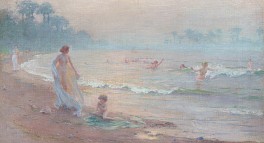BIOGRAPHY

American 1861-1942
ARTIST BIOGRAPHY:
Early American Impressionist Charles Courtney Curran was memorable both for his elegant interior and exterior portraits of women and children, as well as for his leadership role at the Cragsmoor Art Colony. Often compared to fellow American Impressionists Mary Cassatt, Frank Benson, and Edmund Charles Tarbell, Curran’s iconic paintings featuring graceful young women in flowing dresses set against the vast expanse of nature captivated art critics and the public, as well as his contemporaries. Curran’s impressionistic techniques utilizing loose brushstrokes and a vivid palette combined with his nostalgic subject matter encapsulate the leisurely summer beauty of Cragsmoor.
Charles Courtney Curran was born in 1861 in Hartford, Kentucky and raised in Sandusky, Ohio. He studied under Thomas B. Noble at the Cincinnati School of Design for a year before moving to New York City in 1882 where he first attended the National Academy of Design and later studied at the Art Student’s League under Walter Satterlee. At the age of 23, he made his public debut at the Academy of Design, a venue that showcased his work for the remainder of his career. In 1887, Curran’s paintings also began exhibiting at the Pennsylvania Academy where he continued to show his work for nearly three decades. He left for Paris in 1889 where he studied under Jules Lefebvre at the Académie Julian for two years. Upon his return to the United States, the artist settled in New York and began teaching at the Pratt Institute and Art Students League.
In 1903, fellow artist and friend Frederick Dellenbaugh invited Curran to visit Cragsmoor. A bourgeoning summer art center started by Edward Lamson Henry, Cragsmoor was located along a plateau in the Shawangunk Mountains of the Hudson River Valley. Captivated by the landscape and creative atmosphere and Curran set up a summer home and studio. He soon established himself as a central figure of the art colony, painting, teaching, and with the help of his wife, editing the student art publication Palette and Brush during his summers in Cragsmoor. While he is best known for his sweeping landscapes featuring young women and children, Curran also painted many portraits and created a series of works featuring the Imperial Temples of Peking.
For nearly thirty years, until his death in 1942, Curran split his time between Cragsmoor and New York City. He continued to paint and maintained teaching positions at Pratt Institute, Cooper Union, and the National Academy. In addition to his role as a leader of the Cragsmoor Art Colony, Curran remained an active member of the American Water Color Society, Society of American Artists, and the National Arts Club.
Artist’s Statement
EDUCATION:
18823, studied under Thomas B. Noble at the Cincinnati School of Design
National Academy of Design and later studied at the Art Student’s League under Walter Satterlee
1889, he studied under Jules Lefebvre at the Académie Julian, Paris, France.
EXHIBITIONS:
1883-1900, National Academy of Design (1904, 1916, 1920, 1925)
1887-88, Pennsylvania Academy of the Fine Arts (1892-1903, 1905-1906, 1908-1910,
1917-1927)
1888, Art Institute of Chicago (1894-1903, 1905-1907, 1910-1916, 1919)
1888, Art Students League, New York (1890)
1890, Salon, Paris
1893, World’s Columbian Exposition, Chicago
1895, Cotton States and International Exposition, Atlanta
1900, Universal Exposition, Paris
1901, Pan American Exposition, Buffalo
1904, Louisiana Purchase Exposition, St. Louis
1904, Society of American Artists, New York (1906, 1933)
1905, Society of Washington Artists
1911-13, City Art Museum, St. Louis
1980, Henry Art Gallery, University of Washington
MEMBERSHIPS:
American Water Color Society
Allied Artists of America
Cragsmoor Barnstormer’s Theatre
Fencer’s Club
National Academy of Design
National Arts Club
New York Water Color Society
Lotus Club, New York
MacDowell Society
Salmagundi Club
Society of American Artists
AWARDS:
1888, Third Hallgarten Prize in Oils, National Academy of Design
1890, Honorable Mention, Paris Salon
1893, Clark Prize, National Academy of Design
1893, Medal, World’s Columbian Exposition, Chicago
1895, Second Hallgarten Prize, National Academy of Design
1895, Silver Medal, Cotton States and International Exposition, Atlanta
1900, Honorable Mention, Universal Exposition, Paris
1901, Silver Medal, Pan-American Exposition, Buffalo, NY, Assistant Director
1904, Carnegie Prize, Society of American Artists, New York
1904, Silver Medal, Louisiana Purchase Exposition, St. Louis
1905, First Corcoran Prize, Society of Washington Artists
1906, Shaw Fund Prize, Society of American Artists
1920, First Altman Prize, National Academy of Design
1933, Salmagundi Club
